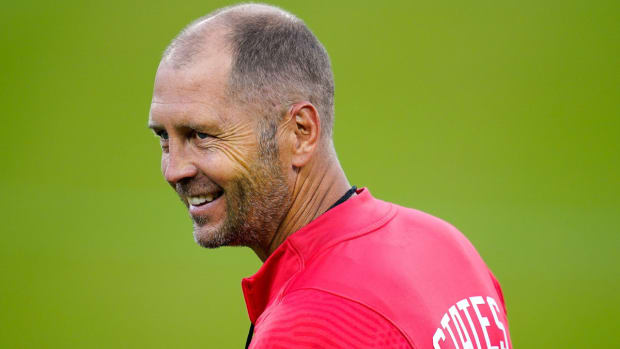World Cup qualifying resumes Thursday, with the U.S. picking up after a hectic, attrition-filled week in September setting the tone for the Concacaf Octagonal.
Everyone expected it to be hard. Everyone knew it was going to be a challenge. But the first window of Concacaf’s Octagonal World Cup qualifying competition was an eye-opening grind nevertheless.
A schedule featuring three games in three countries—all across just seven days—evolved quickly into a battle of attrition for a young U.S. men's national team that kicked off talking about nine points and finished relieved to have five.
Positive COVID-19 tests sidelined goalkeeper Zack Steffen and forced Christian Pulisic to arrive in camp lacking fitness. Pulisic struggled to make a consistent impact and then was lost to an ankle injury suffered during the third qualifier in Honduras. He hasn’t played since. Gio Reyna (hamstring) was hurt during the Octagonal opener in El Salvador and also has remained out of action. Sergiño Dest sprained his ankle in the home draw against Canada and then missed the win over Honduras, while Weston McKennie was suspended for the second two matches after a breach of team rules.
Those five players are among the most prominent in the program. None made it through the first three qualifiers unscathed. U.S. coach Gregg Berhalter used 22 players across the three games, starting 21 of them. And his team was staggering to the finish line before a desperate second-half U-turn in San Pedro Sula, which was sparked by a formation change, several substitutes and 18-year-old debutant Ricardo Pepi.

Christopher Hanewinckel/USA TODAY Sports
“I think that’s great to have high expectations. Everyone wants to win games, right? But the other side of it is, it’s just talk, and then you have to go out and do it. And it’s very difficult to do,” Berhalter said in Honduras. “They needed to see what these games are like because they’re completely different games. … They’re wars. You have teams and countries that are desperate to get wins to get in the World Cup, and it’s a different animal than we were used to.”
Berhalter and his staff approach the October qualifying window, which kicks off Thursday in Austin, armed with that experience and data but facing additional challenges. Pulisic and Reyna remain unavailable. Tyler Adams, who’s emerging as the U.S.’s most indispensable player, had fitness issues after returning to RB Leipzig last month and is carrying a yellow card into the upcoming games against Jamaica, Panama and Costa Rica. He played all 270 minutes during the first window and is one of three Americans—McKennie and DeAndre Yedlin are the others—who face suspension the next time they’re cautioned (John Brooks also would’ve been on the list but has been ruled out of this month’s qualifiers because of back issues).
Then there’s an additional burden placed on players based in England, who must live in modified quarantine for 10 days upon return from a “red list” country. That could impact the availability of Steffen and left back Antonee Robinson for the Panama game on Oct. 10. Fulham defender Tim Ream’s Friday withdrawal and replacement by Walker Zimmerman was unrelated, but still illustrates how fragile roster planning can be.
Considering all this—the travel, schedule, attrition (it’s started already), discipline, injuries, pandemic and more—Berhalter easily could have justified calling up a much larger group. But he increased the squad size by just one player to an initial 27 for this month’s games, calling it a “decent number” when discussing the roster last week (and it's fallen to 26 with Brooks not being replaced). There’s rotation—nine men weren’t part of the team last month—but not much addition.
“It’s a decent group. Any time you have to leave 8–9 players off the game-day roster, it’s never the easiest. But I think the most important thing here is that there were difficult decisions to make,” Berhalter explained. “We tried to put a roster together, a balanced roster, that we feel can compete through all three games.”

Andrew Nelles/The Tennessean/USA TODAY Network
The difficulty in managing a larger group and in leaving that many players off the active squad (only 23 are allowed on match day) appears to be something that’s considered by other coaches as well. They all got a taste of the Octagonal gantlet. Yet among the eight nations vying for three automatic berths in the 2022 World Cup only one, Mexico, is carrying 28 players on its October qualifying roster. Canada, El Salvador, Honduras and Panama announced 27 like the U.S., Costa Rica unveiled a 26-man team and Jamaica will bring only 23 players to Austin this week, before adding a 24th for its remaining two games.
Instead of simply adding numbers, Berhalter will be counting on two things—using what he and the team learned last month, along with the likelihood that the bad luck and bad behavior won’t be repeated.
"The players learned a lot about what these environments are like,” Berhalter claimed last week.
“From a coaching standpoint, I think we learned about rotations and the importance of [and] the impact of substitutes, the impact of getting fresh bodies on, how we can physically wear down opponents, what these games ended up looking like as the window goes on,” he added. “We played 21 different starters in this last window, and that’s a lot. To be juggling that in seven days, to use 21 different starters, is a really interesting task for the coaches. So I think, in general, that’s what we’re taking away, is how we need to use the entire squad to be successful.”
Watch FIFA World Cup qualifying matches online with fuboTV: Start with a 7-day free trial!
Berhalter deployed substitutes to great effect in the win at Honduras, but waited until the 83rd minute of the draw against Canada in Nashville to bring in reinforcements. Not only was that too late to make an impact that night, but it meant that Pulisic—who wasn’t relieved—went 90 minutes during his first game in more than three weeks. He got hurt three days later.
In addition to refining his squad rotation and figuring out ways to deploy his players more evenly across the three upcoming games, Berhalter also tweaked his team based on results. The U.S. struggled to create chances, mustering only four shots on target during the first five halves combined in El Salvador, Nashville and Honduras. The Americans’ inability to move the ball effectively against the frenetic Salvadorans, followed by their failure to stretch or penetrate Canada’s compact low block, left Berhalter convinced that a quicker and more direct approach was required.
“The way we always want to play is to be aggressive, is to break lines, is to play behind the back line. I think one of our benchmarks each game that we discuss with the team is runs behind the back line and I just didn’t think we did that effectively enough, particularly in the first two games,” Berhalter explained.
“That's a focus of ours moving into this next window. At times against Honduras when we started doing it we gave them a ton of problems. And when you have guys like Paul [Arriola], when you have guys like Brenden Aaronson, Gyasi [Zardes], Ricardo Pepi, these guys will stretch the back line—Timmy Weah. They’ll stretch the back line and they’ll look to get behind and that's a really important part of our game. What it does is open up space in the midfield and lets us play more effectively.”

Christopher Hanewinckel/USA TODAY Sports
Arriola, Zardes, Weah and Matthew Hoppe are in while strikers Jordan Pefok and Josh Sargent are out. Zardes is a mobile front-runner and Hoppe is a direct, aggressive and hardworking attacker. Meanwhile, Arriola and Weah are players who thrive staying wide and getting vertical (as opposed to someone like Pulisic, who’s more likely to cut inside). Aaronson was misused as a midfielder in El Salvador. That’s unlikely to happen again thanks to Berhalter’s decision to bring eight midfielders to camp instead of five. Valencia’s Yunus Musah will be a welcome addition (he had just returned from injury before last month's qualifiers), and Gianluca Busio and Luca de la Torre will have the chance to make their qualifying debuts.
“We know we need rotations,” Berhalter said when asked about Busio, who just scored his first goal for Venezia on Friday. “We know we need people who can start the game and also make an impact coming off the bench.”
World Cup qualifiers are, as Berhalter said, a different animal. They’re a series of hurdles, crossroads and curveballs. Certain amounts of adversity and attrition are always going to be beyond an individual team’s control, but learning to adapt—and learning to learn—are going to be critical for the U.S. going forward. Qualifying margins are too thin to risk using players out of their best position, which happened toward the end of the September window. Games are too tight to rely on tiring legs. And nobody’s talking about nine points now. The message from Berhalter and the players who spoke Monday was clear—“one game at time” is more than a cliché.
Berhalter took the first step by acknowledging the team’s struggles in attack last month and the potential issues with roster balance. He set a tone with McKennie’s suspension and subsequent reintegration. He worked over the past year to cultivate the depth that’ll be relied upon in the absence of Pulisic and Reyna. Now the upcoming games in Austin, Panama City and Columbus will be a test of its ability to respond and improve—mentally, physically, individually and collectively. The roster size and composition are the first subtle reflection of that mission.
“Coming into last camp, maybe we were just a little bit naive and we didn’t really know what to expect,” Adams said Monday. “That’s why we had to use those first three games as a learning process. Now you can already see, yeah it’s been one training [in Austin], but at the end of the day, you can tell that the group is focused.”
More Soccer Coverage:
- Brooks, Ream Out for USMNT World Cup Qualifiers
- USMNT Hopeful Scally Scores First Bundesliga Goal
- USMNT's Busio Rescues Point for Venezia With First Goal
- Straus: Berhalter Turns Page on McKennie Incident With Camp Recall
Sports Illustrated may receive compensation for some links to products and services on this website.